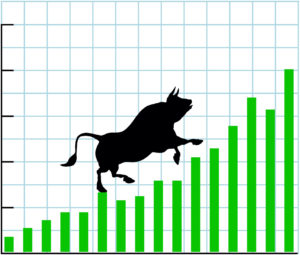When we examine the relationship between Robert Shiller’s Cyclically-Adjusted Price-Earnings (CAPE) ratio to the following decade of stock returns, the correlation is quite weak; the result is closer to a cloud than a straight line. The most we can say is that when the CAPE is high, future expected stock returns appear to be somewhat lower. There is logic to the idea that P/E ratios will likely return to some form of normalcy in the future, but this may take a very long time. In the interim, stocks remain the best bet for future returns.
But at what P/E level can we decide that stocks are no longer a good bet? Shiller’s U.S. CAPE is at 38 as I write this. The highest it’s been in the last 150 years is about 45 in the year 2000. What if the CAPE gets to 45 or higher? At some point, the future of stocks won’t look very bright.
A few months ago I adjusted my investment spreadsheet to assume that my portfolio’s CAPE (a blended figure based on my allocation across Canadian, U.S., and international stock markets) would drop to 20 by the time I reach age 100. I kept the assumption that corporate earnings would keep growing at an average rate of 4% above inflation each year. The effect of this assumed slow reduction of the CAPE is that I would get lower stock returns for the rest of my life, and the amount I can safely spend in retirement is lower. For more about the details of how I calculate my retirement spending level and portfolio allocation, see my glidepath article.
No major change in Asset Allocation
So, this change has me spending a little less money each month, but it didn’t change my asset allocation. A minor technicality is that because I use a fixed income allocation of 5 years worth of my safe retirement spending level, this change would have had me lower my fixed income allocation. I added some calculations to prevent this slight shift to stocks. It would have been ironic if spending less because I’m worried about high stock prices had led me to own more stocks.
The way I made this technical adjustment was to increase the 5-year figure to keep my fixed income allocation the same as it would have been without the CAPE-based reduction in expected future stock returns. This led to another idea. What if I were to increase this 5-year figure even more when the CAPE is very high? The idea is to make a gradual shift toward fixed income as the CAPE grows ever larger.
Previously, I arbitrarily chose 20 as the CAPE level where I’d start to adjust downward the percentage of my portfolio I’d spend each month. So, as stocks keep rising, my spending level rises as well, but not quite as fast as my portfolio goes up. This time, I’m setting another (higher) CAPE level where I’ll gradually increase my fixed income allocation.
I haven’t decided on this second CAPE threshold, but let’s use 30 as an example. If the CAPE is above 30, then I take my 5-year spending figure (adjusted as described earlier if the CAPE is above 20) and multiply it by CAPE/30. So, as the CAPE rises above 30, my fixed income percentage rises. As my stocks rise in value, the absolute dollar amount I have in stocks will keep rising, but slower than it would have risen before, and my fixed income investments would grow faster than they would have before.
Why keep playing the game if you’ve already won?
Unless the stock market does something very sudden, all these adjustments will happen at their usual glacial pace. If the stock market doesn’t crash soon, I’ll make somewhat less money with my lower stock allocation, but that’s fine because I’ve had the enormous benefit of a very long bull run. (Why keep playing the game when you’ve already won?) If the stock market crashes from some CAPE level above 30, I will have protected more of my portfolio than I would have before making this change.
Sharp-eyed readers may wonder whether I’m opening myself up to a bond crash. I don’t buy long-term bonds. My fixed income is currently in high-interest savings accounts, a few GICs, and some short-term government bonds. So, a crash in the bond market wouldn’t affect me much.
I don’t claim that this response to nosebleed stock levels is optimal in any sense. But I do believe it will help me in some stock market crash scenarios without taking away too much of my potential upside. A further benefit is that I can automate it in a spreadsheet and keep my feelings out of any decisions.
 Michael J. Wiener runs the web site Michael James on Money, where he looks for the right answers to personal finance and investing questions. He’s retired from work as a “math guy in high tech” and has been running his website since 2007. He’s a former mutual fund investor, former stock picker, now index investor. This blog originally appeared on his site on July 7, 2021 and is republished on the Hub with his permission
Michael J. Wiener runs the web site Michael James on Money, where he looks for the right answers to personal finance and investing questions. He’s retired from work as a “math guy in high tech” and has been running his website since 2007. He’s a former mutual fund investor, former stock picker, now index investor. This blog originally appeared on his site on July 7, 2021 and is republished on the Hub with his permission



